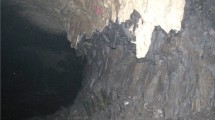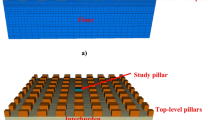Abstract
This paper is a case study of a large-scale pillar collapse at the Everest Platinum Mine. A major contributing factor to the collapse was the presence of weak alteration layers in the pillars. These alteration layers are found in the Bushveld Complex in South Africa where the pyroxenite layers have been exposed to hydrothermal fluid flow, serpentinisation and layer-parallel shearing. The resulting clay-like material and the weak partings substantially reduce the pillar strength. From the literature survey, it is clear that weak seams in pillars reduce their strength and conventional pillar strength formulas overestimate the strength in these cases. As an alternative, a novel numerical modelling approach is proposed to study the pillar failure and to conduct a back analysis of the mine collapse. This consists of a limit equilibrium constitutive model implemented in a displacement discontinuity code. Two areas of the mine were simulated, namely part of the collapsed area and a second area, with larger pillars that is still stable. This allowed for a preliminary calibration of the limit equilibrium model. The model illustrated that a reduction in friction angle on the partings, owing to the presence of water in the collapse area, seems to be a factor that contributed to the collapse. Although encouraging results are obtained, calibration of the limit equilibrium model remains a challenge. Laboratory testing is required in future to determine the strengths of the weak partings and in particular, the difference in strength of the wet and dry alteration zone material.
Highlights
-
Geological alterations substantially reduce the strength of hard rock pillars and the classical approach of using empirical pillar strength formulae for layout design does not work in these cases.
-
A novel approach to simulate the pillar failure on a mine-wide scale is presented in this paper and this consists of a displacement discontinuity boundary element method using a limit equilibrium model to represent the pillar failure.
-
The collapse of the Everest Platinum Mine in South Africa is described in the paper, it is used to test the proposed methodology, and it provides valuable data for researchers interested in case studies where pillar strength is reduced by weak layers.
-
The proposed modelling methodology seems valuable to simulate the pillar failure and to design layouts for these types of ground conditions. Calibration of the limit equilibrium model remains a challenge, however.















Similar content being viewed by others
References
Alejano LR, Arzua J, Castro-Filgueira U, Malan F (2017) Strapping of pillars with cables to enhance pillar stability. J S Afr Inst Min Metall 117:527–540
Crouch SL, Starfield AM (1983) Boundary element methods in solid mechanics. George Allen and Unwin, London
Deist FH, Georgiadis E, Moris JPE (1972) Computer applications in rock mechanics. J S Afr Inst Min Metall 72:265–272
Deng S, Chen Y, Hou J, Feng J, Yang Y, Wu X (2018) Study on the influence of soil moisture content on the probability of landslide instability. In: 8th international conference on manufacturing science and engineering (ICMSE 2018), pp 532–536
Du Plessis M, Malan DF, Napier JAL (2011) Evaluation of a limit equilibrium model to simulate crush pillar behavior. J S Afr Inst Min Metall 111:875–885
Eriksson PG, Hattingh PJ, Altermann W (1995) An overview of the geology of the Transvaal Sequence and Bushveld Complex South Africa. Miner Depos 30(2):98–111
Esterhuizen GS, Dolinar DR, Ellenberger JL (2011) Pillar strength in underground stone mines in the United States. Int J Rock Mech Min Sci 48:42–50
Esterhuizen GS, Tyrna PL, Murphy MM (2019) A case study of the collapse of slender pillars affected by through-going discontinuities at a limestone mine in Pennsylvania. Rock Mech Rock Eng 52:4941–4952
Esterhuizen GS, Ellenberger JL (2007) Effects of weak bands on pillar stability in stone mines: field observations and numerical model assessment. In: Proceedings of 26th international conference on ground control in mining. Morgantown, West Virginia, pp 320–326
Gonzalez-Nicieza C, Alvarez-Fernandez M, Menendez-Diaz A (2006) A comparative analysis of pillar design methods and its application to marble mines. Rock Mech Rock Eng 39:421–444
Hartzenberg AG, Du Plessis M, Malan DF (2019) The effect of alteration layers on UG2 pillar behaviour in the Bushveld Complex. In: Proceedings 14th ISRM Congress, Foz do Iquacu, Brazil, 13–18 Sept 2019
Heasley KA (1998) Numerical modeling of coal mines with a laminated displacement-discontinuity code. PhD Dissertation, Colorado School of Mines
Hedley DGF, Grant F (1972) Stope-and-pillar design for Elliot Lake uranium mines. Bull Can Inst Min Metall 65:37–44
Lunder PJ, Pakalnis R (1997) Determination of the strength of hard rock mine pillars. Bull Can Inst Min Metall 68:55–67
Malan DF, Napier JAL (2011) The design of stable pillars in the Bushveld mines: a problem solved? J S Afr Inst Min Metall 111:821–836
Martin CD, Maybee WG (2000) The strength of hard-rock pillars. Int J Rock Mech Min Sci 37:1239–1246
Napier JAL, Malan DF (2007) The computational analysis of shallow depth tabular mining problems. J S Afr Inst Min Metall 107:725–742
Napier JAL, Malan DF (2018) Simulation of tabular mine face advance rates using a simplified fracture zone model. Int J Rock Mech Min Sci 109:105–114
Napier JAL, Malan DF (2021) A limit equilibrium model of tabular mine pillar failure. Rock Mech Rock Eng 54:71–89
Plewman RP, Deist FH, Ortlepp WD (1969) The development and application of a digital computer method for the solution of strata control problems. J S Afr Inst Min Metall 70:33–44
Roberts MKC, Clark-Mostert V (2010) Is there some commonality between the geological structures in the Bushveld Complex and the Great Dyke? In: The 4th international platinum conference, platinum in transition ‘Boom or Bust’. S Afr Inst Min Metall, pp 149–155
Ryder JA, Napier JAL (1985) Error analysis and design of a large-scale tabular mining stress analyser. In: 5th international conference on numerical methods in geomechanics, Nagoya, Japan, pp 1549–1555
Salamon MDG (1964) Elastic analysis of displacements and stresses induced by mining of seam or reef deposits—II. Practical methods of determining displacements, strain and stress components from a given mining geometry. J S Afr Inst Min Metall 64:197–218
Stacey TR, Page CH (1986) Practical handbook for underground rock mechanics. Series on rock and soil mechanics, vol 12. Trans Tech Publications, Clausthal-Zellerfeld, Germany, pp 53–63
Wyllie DC, Norrish, NI (1996) Rock strength properties and their measurement. Landslides: Investigation and mitigation. Transportation Research Board Special Report, Washington, no. 247, pp 372–390
Acknowledgements
This work forms part of the MSc study of the principal author, Paul Couto, at the University of Pretoria. The authors would like to thank Mr. Noel Fernandes for permission to use the historic data of the Everest Platinum Mine collapse.
Author information
Authors and Affiliations
Corresponding author
Additional information
Publisher's Note
Springer Nature remains neutral with regard to jurisdictional claims in published maps and institutional affiliations.
Rights and permissions
Springer Nature or its licensor holds exclusive rights to this article under a publishing agreement with the author(s) or other rightsholder(s); author self-archiving of the accepted manuscript version of this article is solely governed by the terms of such publishing agreement and applicable law.
About this article
Cite this article
Couto, P.M., Malan, D.F. A Limit Equilibrium Model to Simulate the Large-Scale Pillar Collapse at the Everest Platinum Mine. Rock Mech Rock Eng 56, 183–197 (2023). https://doi.org/10.1007/s00603-022-03088-z
Received:
Accepted:
Published:
Issue Date:
DOI: https://doi.org/10.1007/s00603-022-03088-z




